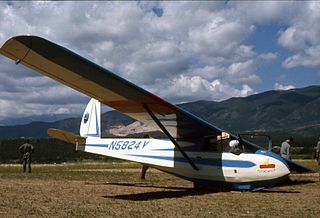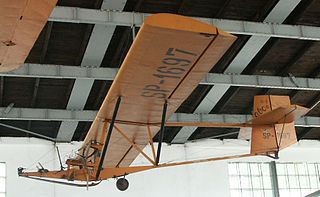
The Elliots Primary EoN or EoN Type 7 S.G.38 Primary was a training glider built in the UK shortly after World War II. It was an absolutely minimalist aircraft, consisting of a high, cable-braced wing connected to a conventional empennage by an open-truss framework, and was a copy of the German SG 38 Schulgleiter. Marketed to aeroclubs, the Primary EoN was also adopted in 1948 by the Air Training Corps and by the Combined Cadet Force under the name Eton TX.1. An example is at the Gliding Heritage Centre.

The Frankfort Cinema is a sailplane manufactured in the United States in the 1930s and 1940s and which was used by the United States Army Air Corps as a training glider under the designation TG-1. It was a high-wing, strut-braced design with a fully enclosed cabin. Originally designed as a single-seater, a two-seat version designated the Cinema II was produced soon afterwards, and this design was put forward when the Army issued a requirement for training gliders. At the same time, the company was awarded production contracts for transport gliders, the CG-1 and CG-2.

The Schweizer SGU 2-22 is an American two-seat, high-wing, strut-braced, training glider built by Schweizer Aircraft of Elmira, New York.

The PIK-5 was a training glider produced in Finland in the 1940s, and 1950s, equipping the country's gliding clubs with an aircraft greater in performance than primary gliders but less than competition sailplanes.

The SZD-18 Czajka was a single-seat glider designed and built in Poland in 1956.

The W.W.S. 1 Salamandra (Salamander) was a single-seat training glider designed and built in Poland from 1936, and again from 1947 after World War II as IS-A Salamandra.

The WWS-2 Żaba (Frog) was a single-seat training glider designed and built in Poland from 1937.

The IS-3 ABC was a single-seat training glider designed and built in Poland from 1947.

The Schneider DFS 108-14 SG-38 Schulgleiter is a German high-wing, cable-braced, single-seat primary glider that was designed by Schneider, Rehberg and Hofmann at Edmund Schneider's factory at Grunau in 1938, hence the designation. It was produced by several builders, including Deutsche Forschungsanstalt für Segelflug (DFS).

The FAJ Jastreb Vuk-T often called Vuk is a Standard Class single-seat high-performance glider, intended for transition training, designed and built in the Yugoslavia from the late 1970s.

The Politechnika Warszawska PW-2, also called the PW-2 Gapa, is a Polish lightweight high-wing, strut-braced single-seat, glider that was designed and built at the Warsaw University of Technology and also produced by DWLKK in the early 1990s. Total number of 19 gliders were built, including variant PW-2D bis.

The Pegasus Quik is a British-designed ultralight trike, originally designed and produced by Pegasus Aviation, later by P&M Aviation, both of the United Kingdom. The design is now owned by Albatross Flying Systems of Bangalore, India. The aircraft is supplied as a kit for amateur construction.
The Grif H2000 is an Italian high-wing, single and two-place family of hang gliders, designed and produced by Grif Italia, of Castel Sant'Elia.

The SVC Mačka was a single-seat acrobatic glider of wooden construction with undercarriage skis for landing. It was constructed and produced at Savezni Vazduhoplovni Centar (SVC) in Vršac. It was the only acrobatic glider constructed in Yugoslavia.
The Teichfuss Allievo Pavullo was an Italian single seat open frame primary glider, designed by Luigi Teichfuss of Pavullo and first flown in 1940. It was sold in two versions, strut and cable braced. A single two seat variant was also built.

The Scheibe Specht is a tandem seat training glider produced in Germany in the early 1950s. More than fifty were built.
The IFIL-Reghin RG-4 Pionier or CIL Reghin RG-4 Pionier was a Romanian single seat primary glider built in the 1950s. Fifty were produced.
The Moyes Malibu is an Australian high-wing, single-place, hang glider designed and produced by Moyes Delta Gliders of Kurnell, New South Wales. The aircraft is supplied complete and ready-to-fly.
The Moyes Sonic is an Australian high-wing, single-place, hang glider that was designed and produced by Moyes Delta Gliders of Botany, New South Wales. Now out of production, when it was available the aircraft was supplied complete and ready-to-fly.

The Czerwiński CW 8 was a mid-1930s Polish open-frame basic training glider. Its design was advanced and its price low, but its stalling characteristics were too dangerous for beginners, so the thirty-plus examples completed were rapidly withdrawn from use. Two were subsequently modified, one with greater span and the other with a small engine.















